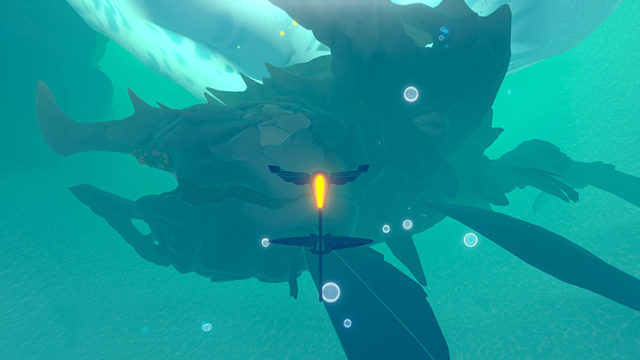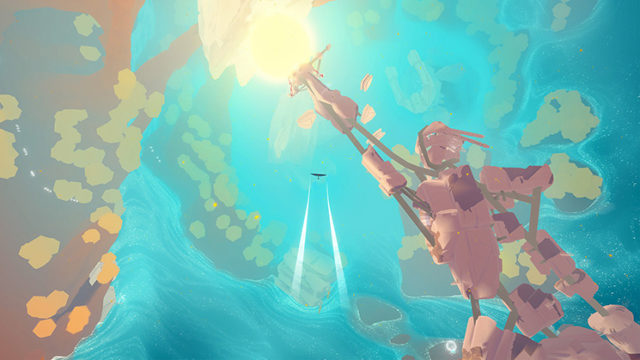Fantastic art direction; unique spherical worlds presents new gameplay and design ideas.
Easy to become disoriented due to the unique worlds and lack of direction; not enough gameplay diversity.
Game developers seem to be big on exploration right now. Whether it is a massive world like in Breath of the Wild or a smaller, yet thoroughly detailed environment, like in Gone Home, more and more games are letting their worlds better define their gameplay and story. InnerSpace, developed by PolyKnight Games, seems to have embraced this zeitgeist, albeit with a significant, unique twist by keeping exploration airborne.
In InnerSpace, players assume the role of a flying AI brought to life by the Archaeologist, a researcher exploring the crumbling ruins found within the Inverse. This mysterious world is made of interconnected spheres in which a lost civilization once thrived but is now fading away. Since the Archaeologist is on a boat and stuck to the oceans of the Inverse, you are tasked with taking to the air to learn what you can about this dead society via the remaining relics they created and the once great Demigods they once worshiped. While plenty of this history is conveyed through text and dialogue, the world itself says just as much in its state of beautiful ruin.
In terms of gameplay, this translates to rather simple flying mechanics. Controlling your airframe is very straightforward with a focus on accessibility and ease of use of hardcore realism. That being said, there are a few mechanics that InnerSpace introduces. First is the ability to drift, which translates to holding down the shoulder button to let you quickly reorient your airframe before quickly darting off in your new direction. Your airframe also functions as a submarine, so you can enter a diving free-fall to make your transition to water more efficient. The game also employs some rather clever, albeit simple, environmental puzzle solving based on these mechanics. As you explore and uncover more relics, you’ll unlock new airframes and upgrades that change certain aspects of the controls, such as overall speed and maneuverability. Regardless of what vehicle you’re using and whether you are in the air or underwater, the game feels responsive and easy to master.

Beyond the stated objective of hunting down relics, the Inverse itself is worthy of exploration thanks to its appealing design. The various spheres that make up the game are beautiful to behold and play host to a number of unique and interesting sights ranging from massive statues to what almost appear to be alien creatures or constructs frozen in place. The limited color palette that heavily emphasizes blues, oranges, and purples just further enhances the impression that you are experiencing a world quite unlike anything else you’ve seen in another game.
Beyond the creative visual design of the Inverse, InnerSpace’s true defining feature is how these environments are contained within spheres with gravity always pulling toward the outside edges of the world. While this concept further enhances the unique look and feel of the game, it unfortunately also contributes to a general sense of disorientation. The game isn’t big on hand-holding as it wants you to explore on your own, but this lack of direction hurts the overall fun factor when combined with having to explore a world designed in a way the human brain is literally not conditioned to easily comprehend. You do get an audio clue whenever you are near a relic, but figuring out the proper path through the air, water, caves, and tunnels of such an alien environment is challenging in a way that is often more frustrating that rewarding. Of course, time does slowly make this process somewhat easier, but it never feels natural.

Unfortunately, InnerSpace is further hurt by a general lack of motivation. While the game is visually beautiful and obviously designed with great artistic care, there ultimately really isn’t that much to behold. Repetition ultimately robs the worlds of their luster as you fly back and forth for the hundredth time looking for relics and, given how disorienting the spheres can be, you’ll often find yourself revisiting areas quite unintentionally. Before too long, these unique environments feel less like alien worlds worth exploring and more like haystacks with an ever shrinking number of needles.
InnerSpace is definitely a game that earns plenty of kudos for the sheer effort and creativity put into it. The art direction is truly gorgeous and the spherical worlds present both visual and gameplay concepts unlike anything else out there. When you take the gameplay into account, however, this unique experience is marred by a sense of disorientation. Ultimately, InnerSpace could have benefited from more gameplay diversity than the constant relic hunting as well as some sort of mapping or guidance system to make navigating its unnatural worlds easier to acclimate to. So, while the game presents a creative concept that will undoubtedly appeal to many gamers, that same ingenuity comes at a cost to the core gameplay.
Nintendojo was provided a copy of this game for review by a third party, though that does not affect our recommendation. For every review, Nintendojo uses a standard criteria.




 ShareThis
ShareThis





